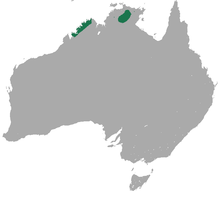Nabarlek
| Nabarlek | |
|---|---|

| |
| Petrogale cocinna by John Gould and H. C. Richter , Mammals of Australia (1863)
| |
| Scientific classification | |
| Domain: | Eukaryota |
| Kingdom: | Animalia |
| Phylum: | Chordata |
| Class: | Mammalia |
| Infraclass: | Marsupialia |
| Order: | Diprotodontia |
| Family: | Macropodidae |
| Genus: | Petrogale |
| Species: | P. concinna
|
| Binomial name | |
| Petrogale concinna | |

| |
| Distribution within Australia (green) | |
| Synonyms | |
| |
The nabarlek (Petrogale concinna) is a small species of macropod found in northern Australia. They are a shy and nocturnal animal that resides in rocky hollows and forages in the surrounding area. Their diet is grasses, sedges, and ferns found in and around their scrub covered refuges. They are distinguished by a reddish tinge to the mostly grey fur and a distinct stripe at the cheek. They move with great speed and agility when observed, with a forward leaning posture and a bushy tail that arches over the back.
Etymology
The name comes from the
Taxonomy
Nabarlek is most closely related to the monjon and to the short-eared rock-wallaby
The common name designated for a similar species, monjon for P. burbidgei, is also used to refer this species in the Kimberley region; the two species are however known to be distinct by the indigenous people from whose language the name derives.[6] Common names for the species include the little rock-wallaby[7][8] or pygmy rock-wallaby.
Subspecies
Three subspecies have been recognised:[9]
- P. concinna concinna Gould, 1842
The nominate subspecies, found at the Top End, follows Gould's original description.
- P. concinna canescens Thomas, 1909
The Arnhem Land population. The description for this subspecies was published by
- P. concinna monastria (Thomas, 1926)
A subspecies restricted to the Kimberley region.
Description
A species of
The dentition of P. cocinna is unique amongst the marsupial species, with the supernumerary molars being continually replaced. These teeth emerge in a regular size and shape, with each row containing four to six molars and another that is yet to erupt. The early loss of the premolar appears to allow this regeneration to continue throughout their life.[8]
Nabarlek is often found with the similar P. brachyotis, whose coloration is more variable, and a young individual may be indistinguishable from this species in field observations.[11]
Behaviour
Nabarlek move quickly with a distinctive horizontal posture, the tail curled toward the middle of the back with raised hairs in the tufty end. The species has a timid disposition, although is somewhat gregarious in associations with others. Their feeding and other activities is usually nocturnal, and they may range beyond their refuge to forage.
The species will range several hundred metres from its secure position, foraging in the surrounding black soil terrain, this contrasts with the less venturous behaviour of the short-eared P. brachyotis.[8]
The discrete and cautious nature of narbarlek makes capture of specimens difficult, they are regarded as 'trap-shy' in attempts to survey their population.[11]
Diet
The diet includes a variety of plants, including grasses, ferns and sedges.[7] The plants consumed in Arnhem land during the wet season are the grass species of Eriachne and the sedges Cyperus cuspidatus and species of Fimbristylis, which occur in soils above the flood levels. The change in season has the species seek shelter during the day in sandstone formations and forage at local billabongs for a fern species Marsilea crenata.
The high percentage of silica in its diet, 15 to 25% in some foliage, was proposed to have favoured the continual regeneration of molars.[8] Attempts to locate the high silica fern in later surveys have not recorded Marsilea crenata at any sites, and the complex relationship between diet and dentition remains to be examined.[11]
Distribution and habitat
The nabarlek is found in three distinct and geographically remote populations, one in Arnhem Land which includes Groote Eylandt, a larger island in the Gulf of Carpentaria, and another population between the Mary and Victoria Rivers at the Top End of the continent. The population in the northwest Kimberley region is confined to the coastal areas and on some of the islands in the Bonaparte Archipelago, these are Borda, Long, Hidden and Augustus Islands.[7]
The habitat is usually scrubby vegetation over sandstone formations, granitic outcrops, breakaways of laterite, boulder piles and rocky slopes.[7]
Conservation
It is classified as
References
- . Retrieved 19 November 2021.
- ^ a b c Gould, J. (1842). "On a New Species of Petrogale — P. concinna". Proceedings of the Zoological Society of London. 1842. Academic Press, [etc.]: 57.
- ^ Garde, Murray. "nabarlek". Bininj Kunwok Online Dictionary. Bininj Kunwok Regional Language Centre. Retrieved 29 May 2019.
- ^ "Woman has uranium rights". Canberra Times. 1970-09-02. Retrieved 2024-04-16.
- ^ OCLC 62265494.
- ^ Burbidge, Andrew A.; Fuller, Phillip J. (1990). "On the vernacular name of Petrogale burbidgei". Records of the Western Australian Museum. 14 (4): 645–646.
- ^ ISBN 9780195573954.
- ^ ISBN 0207144540.
- ^ "Petrogale concinna Gould, 1842complete". Australian Faunal Directory. Retrieved 7 March 2019.
- .
- ^ doi:10.1071/AM97297.

